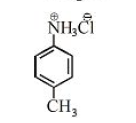Chloroform contains chlorine but gives no reaction with AgNO3 solution. Why?
To understand why chloroform (CHCl₃) does not react with silver nitrate (AgNO₃) despite containing chlorine, we can break down the reasoning step by step.
Step 1: Understanding Chloroform's Structure
Chloroform has the chemical formula CHCl₃. This means it consists of one carbon atom (C), one hydrogen atom (H), and three chlorine atoms (Cl). The structure can be visualized as:
H|Cl−C−Cl|Cl
Step 2: Reaction with Silver Nitrate
When silver nitrate (AgNO₃) is introduced, it is expected that a reaction might occur where silver chloride (AgCl), a white precipitate, could form. The reaction can be represented as:
\(
\text{CHCl}_3 + \text{AgNO}_3 \rightarrow \text{AgCl} + \text{other products}
\)
However, this reaction does not occur.
Step 3: Stability of the Carbocation
For a reaction to proceed, a carbocation (positively charged carbon species) would typically need to be formed. In this case, if a chlorine atom were to leave, it would generate a carbocation:
\(
\text{C}^+
\)
However, the stability of this carbocation is crucial.
Step 4: Electron-Withdrawing Effect of Chlorine
Chlorine is an electronegative element and exhibits a -I (inductive) effect, which means it withdraws electron density from the carbon atom. This withdrawal destabilizes the positive charge on the carbocation:
- The presence of three chlorine atoms creates a situation where the positive charge on the carbocation is not stabilized.
- Instead of stabilizing the carbocation, the chlorine atoms make it less stable due to their electron-withdrawing nature.
Step 5: Conclusion
Since the carbocation formed from chloroform is less stable due to the -I effect of the chlorine atoms, the reaction with silver nitrate does not proceed. Therefore, chloroform does not react with AgNO₃, and no precipitate of AgCl is formed.
Final Answer
Chloroform contains chlorine but does not react with AgNO₃ because the carbocation that would form is destabilized by the electron-withdrawing -I effect of the chlorine atoms, preventing the reaction from proceeding.
---
Chloroform has the chemical formula CHCl₃. This means it consists of one carbon atom (C), one hydrogen atom (H), and three chlorine atoms (Cl). The structure can be visualized as:
H|Cl−C−Cl|Cl
When silver nitrate (AgNO₃) is introduced, it is expected that a reaction might occur where silver chloride (AgCl), a white precipitate, could form. The reaction can be represented as:
\(
\text{CHCl}_3 + \text{AgNO}_3 \rightarrow \text{AgCl} + \text{other products}
\)
However, this reaction does not occur.
For a reaction to proceed, a carbocation (positively charged carbon species) would typically need to be formed. In this case, if a chlorine atom were to leave, it would generate a carbocation:
\(
\text{C}^+
\)
However, the stability of this carbocation is crucial.
Chlorine is an electronegative element and exhibits a -I (inductive) effect, which means it withdraws electron density from the carbon atom. This withdrawal destabilizes the positive charge on the carbocation:
- The presence of three chlorine atoms creates a situation where the positive charge on the carbocation is not stabilized.
- Instead of stabilizing the carbocation, the chlorine atoms make it less stable due to their electron-withdrawing nature.
Since the carbocation formed from chloroform is less stable due to the -I effect of the chlorine atoms, the reaction with silver nitrate does not proceed. Therefore, chloroform does not react with AgNO₃, and no precipitate of AgCl is formed.
Chloroform contains chlorine but does not react with AgNO₃ because the carbocation that would form is destabilized by the electron-withdrawing -I effect of the chlorine atoms, preventing the reaction from proceeding.
Topper's Solved these Questions
- BOOK - MODERN PUBLICATIONCHAPTER - HALOALKANES AND HALOARENESEXERCISE - NCERT In-text Questions8videos
HALOALKANES AND HALOARENES
- BOOK - MODERN PUBLICATIONCHAPTER - HALOALKANES AND HALOARENESEXERCISE - NCERT Textbooks Exercises1videos
HALOALKANES AND HALOARENES
- BOOK - MODERN PUBLICATIONCHAPTER - HALOALKANES AND HALOARENESEXERCISE - PRACTICE PROBLEMS29videos
HALOALKANES AND HALOARENES
- BOOK - MODERN PUBLICATIONCHAPTER - EQUILIBRIUMEXERCISE - Unit Practice Test13videos
EQUILIBRIUM
- BOOK - MODERN PUBLICATIONCHAPTER - HYDROCARBONSEXERCISE - UNIT PRACTICE TEST15videos
HYDROCARBONS
Similar Questions
An inorganic compound (A) loses its water of crystallisation on heating and its aqueous solution gives the following reactions:
a. It gives a white turbidity with dil HCI.
b. It decolourises a solution of iodine in KI.
c. It gives a white ppt. with AgNO3 solution, which turns black on standing.View SolutionOut of benzyl chloride and chlorobenzene, which will give a white precipitate with AgNO3 solution?
View Solution
Knowledge Check
- Question 1 - Select One
The most reactive compound toward reaction with AgNO3 solution is :-
A B
B C
C D
D
- Question 2 - Select One
The most reactive compound toward reaction with AgNO3 solution is :-
A B
B C
C D
D
- Question 3 - Select One
Which one of the following is likely to give a precipitate with AgNO3 solution ?
ACH2=CH−ClBCCl4CCHCl3D(CH3)3CCl
Which one of the following does not give a precipitate with AgNO3 solution ?
View SolutionA: The complex (CONH,Cl gives white ppt with AgNO3 solution
R: Chlorine always gives white ppt with AgNO3 solutionView SolutionAmong the following which compound gives precipitate with AgNO3 solution?
View SolutionChloroform on reaction with conc. HNO3 gives
View SolutionWhich of the following compounds will give curdy precipate with AgNO3 solution?
View Solution
